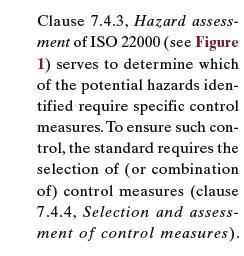Dear Arya,
Thks yr very interesting list and comments. I'm sure a lot of people are appreciating yr post. 
You omitted to mention whether your ISO 22000 system is already approved ?? If so, you (and especially yr consultant) will probably not agree with the following but never mind. 
I am not a current user of ISO 22000 so cannot use any personal auditing experience here however I suspect that different interpretations of the ISO 22000 may be in use.?
A strict reading of ISO 22000 and 22004 seems (to me) to more closely agree with this comment made earlier by Modares (I will ignore aspects like verification / monitoring…)
I'm not agree with this method (Form 7: Hazard Analysis and CCP Determination Worksheet) , because you do:
1. Determination the step's hazards,
2. Assessment the hazards,
3. Based on Risk Assessment, the Process Step is a CCP or is controlled with a PRP/RAP or OPRP.
But in accordance with ISO 22K requirements in 7.4 you should:
1. Determination the step's hazards,
2. Assessment the hazards,
3. Based on the hazard assessment, an appropriate combination of control measures shall be selected,
4. The control measures selected shall be assessed and then categorized as to whether they need to be managed through OPRP or by the HACCP plan.
The difference is that in Codex Decision Tree or in this attached form, the result of hazard assessment determines CCP, but in 22K determines control measures that by a new form of Decision Tree , should be assessed, then the results of this control measures assessment determines CCP and how management of them.
(
http://www.ifsqn.com...?showtopic=3183 )
But fig 2 in iso 22004 implies that hazard assessment is carried out as per Codex (box 7.4.3) which would presumably allow (but
not mandate) use of the standard Decision Tree. (Note that this tree does not include oprp options at all so obviously some new change / expansion would be required if a selection for oprp is made within this chain)
Perhaps an article published (2006) by a member of the original drafting team clarifies the issue. This includes the statement –

The article link is –
 ISO_22k_22000_didier_blanc____some_concepts_and_terminology.pdf 381.73KB
388 downloads
ISO_22k_22000_didier_blanc____some_concepts_and_terminology.pdf 381.73KB
388 downloadsFig 1 in the article also indicates that some boxes in the iso 22004 / fig2 are “significantly altered and consolidated, compared to Codex Alimentarius” although not shown as such in the iso document. (but
not 7.4.3)
I also note that in documents iso 22000 / 22004 there is no mention of the use of the traditional Codex decision (d) tree anywhere. In fact the only specific mention is (I think) to the severity / (likelihood of occurrence) functions (7.4.3/22000) which are implicit in the use of the standard codex Dtree but frequently not stated as such.
So I suggest that ISO does not intend the dtree to be used to finalise the choice of oprps / ccps. Nonetheless I can understand the temptation to follow this route since many people will already be using dtrees to finalise
ccps in traditional
haccp systems. My sympathies.
The obvious follow-up question is – How many people have approved ISO 22000 systems using a (direct) dtree approach to select oprps ? They are very welcome to post a rebuttal to the above.
Rgds / Charles.C
PS - regarding yr query as to inclusion of quality (=non-safety) issues, this simply seems not correct in the present context.
![]()




























